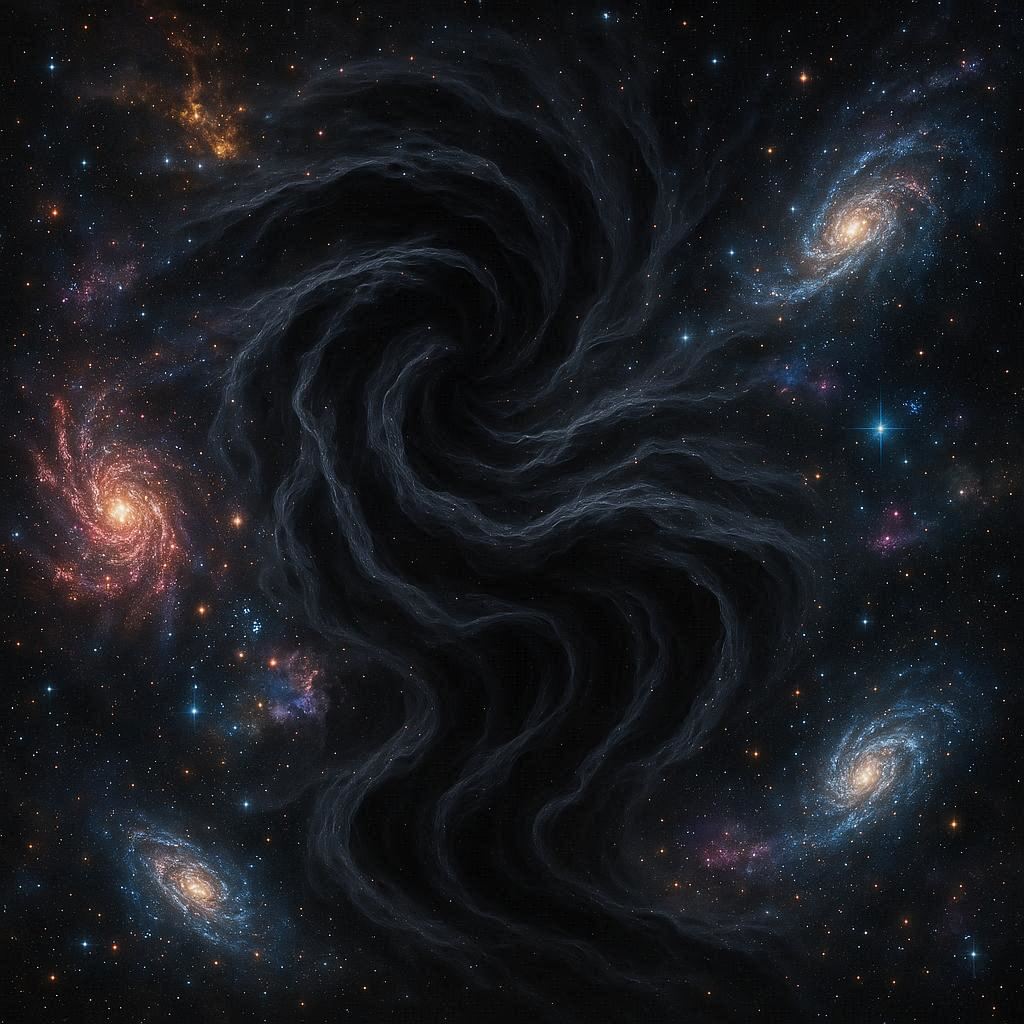When we gaze at the night sky, our eyes meet a tapestry of stars, galaxies, and glowing nebulae scattered across the darkness. To the naked eye, it feels as though the universe reveals itself in all its majesty. Yet modern astronomy has delivered a startling revelation: everything we see—every star, planet, cloud of gas, and grain of dust—constitutes less than five percent of the universe. The overwhelming majority of reality remains invisible, untouchable, and almost unknowable. Scientists call these unseen forces dark matter and dark energy, terms that capture both their obscurity and their importance.
The discovery of these cosmic components has transformed our understanding of the universe. Where once we believed the cosmos was a grand collection of luminous objects governed by the laws of gravity and electromagnetism, we now realize that invisible entities dominate its structure and fate. To explore dark matter and dark energy is to confront the profound mysteries of existence itself. They are not peripheral curiosities; they are the scaffolding and engine of the universe.
The Weight of the Invisible: The Clues to Dark Matter
The story of dark matter begins not with what we see but with what we cannot explain. In the early twentieth century, astronomers carefully observed the motion of stars within galaxies. According to Newton’s laws of motion and gravity, stars farther from the center of a galaxy should orbit more slowly, much as planets far from the Sun move sluggishly compared to those nearby. Yet the observations defied expectation.
When astronomer Vera Rubin meticulously measured the rotational speeds of stars in the Andromeda Galaxy in the 1970s, she found something astonishing: stars far from the center were moving just as quickly as those closer in. The galaxy’s outskirts spun as though held together by some invisible glue. Without it, the stars should have flown apart, scattering into space. This invisible glue, Rubin concluded, was evidence of unseen mass.
That hidden mass, which did not emit or absorb light, came to be known as dark matter. It revealed itself only through gravity, tugging on galaxies and shaping their motion, yet remaining otherwise elusive. The name “dark” was less a description than an admission of ignorance.
Gravitational Lenses and the Cosmic Web
The evidence for dark matter grew stronger with the discovery of gravitational lensing. According to Einstein’s general theory of relativity, massive objects bend the fabric of space, causing light to curve as it passes by. When astronomers observed distant galaxies, they noticed their light was distorted by invisible masses lying in the foreground. The distortions were too strong to be caused by visible matter alone. Something unseen—something with enormous mass—was warping space and magnifying the background galaxies.
Further evidence came from computer simulations of the universe. When astrophysicists modeled how galaxies and clusters should form under the influence of gravity, they found that the structures only matched reality if vast amounts of invisible matter were included. Without dark matter, the universe would be a very different place: galaxies might never have formed, stars might not have clustered, and the night sky would be a barren void.
The universe, it seemed, was a cosmic web woven from strands of dark matter, with galaxies like beads strung along its filaments. Invisible though it was, dark matter dictated the grand architecture of the cosmos.
What Could Dark Matter Be?
If dark matter is real, the next question is simple yet profound: what is it made of? Astronomers and physicists have pursued this mystery for decades, proposing candidates that range from exotic particles to overlooked celestial objects.
One early suggestion was that dark matter might consist of faint stars, black holes, or cold clouds of gas—ordinary matter that simply escaped detection. These hypothetical objects were collectively called MACHOs (Massive Compact Halo Objects). While some evidence for MACHOs was found, their numbers proved insufficient to account for all the missing mass.
Attention then turned to the realm of particle physics. Scientists proposed entirely new types of particles that could explain dark matter’s properties. The leading candidates included WIMPs (Weakly Interacting Massive Particles), hypothetical particles that would rarely interact with ordinary matter, and axions, ultralight particles that might permeate space like a ghostly mist.
Experiments deep underground, in particle accelerators, and even in space have sought to detect these particles directly, but so far they have remained hidden. Each failed attempt deepens the mystery, yet also sharpens our understanding. It is possible that dark matter is not one particle but a combination, or something stranger than physics has yet imagined.
The Dark Side of the Equation: Dark Energy Emerges
As mysterious as dark matter is, it is only half the story. In the late 1990s, astronomers uncovered an even more baffling phenomenon: dark energy.
For much of the twentieth century, scientists assumed that the expansion of the universe, which began with the Big Bang, must be slowing down under the pull of gravity. It seemed natural that the galaxies, drawn to one another by their mutual attraction, would eventually decelerate, perhaps even collapse back in a “Big Crunch.”
To test this idea, two independent teams of astronomers observed distant supernovae, colossal stellar explosions that serve as “standard candles” for measuring cosmic distances. The results shocked the scientific community. Instead of slowing down, the universe’s expansion was accelerating. Galaxies were not only rushing apart but doing so faster and faster, as though propelled by a mysterious force.
This repulsive energy, driving cosmic acceleration, was named dark energy. Unlike dark matter, which pulls things together through gravity, dark energy pushes them apart, working against gravity to stretch space itself. Its discovery transformed cosmology and revealed that the fate of the universe depends on forces we barely understand.
The Nature of Dark Energy
Dark energy is perhaps the most perplexing concept in modern physics. Unlike dark matter, it is not localized in galaxies or clusters but appears to be spread evenly throughout space. It behaves less like a substance and more like a property of the universe itself.
One explanation arises from Einstein’s own equations. In 1917, seeking a static universe, he introduced a term called the “cosmological constant,” a kind of anti-gravity built into space. When later observations showed that the universe was expanding, Einstein abandoned this constant, calling it his “biggest blunder.” Yet in the age of accelerating expansion, his discarded idea returned in a new light. Perhaps dark energy is nothing more than this cosmological constant, a property of space that drives expansion.
Other theories suggest dark energy may be a dynamic field, changing over time, sometimes called quintessence. More radical ideas propose that our understanding of gravity itself may be incomplete, and that what we attribute to dark energy is a sign of new physics waiting to be discovered.
Whatever its nature, dark energy dominates the cosmos, accounting for about seventy percent of all its energy. It is not a mere curiosity—it is the destiny of the universe.
The Universe’s Invisible Balance
Today’s cosmological picture is startling. Ordinary matter, the stuff of stars, planets, and people, makes up less than five percent of the cosmos. Dark matter contributes about twenty-seven percent, while dark energy fills the remaining sixty-eight. In other words, nearly everything that exists is invisible and mysterious.
This revelation forces a profound rethinking of our place in the universe. For centuries, humanity believed that Earth was the center of creation, only to learn that it was a planet orbiting an ordinary star in a typical galaxy. Now we learn that even the matter that makes up our bodies is but a minor component of the cosmic ledger. We are creatures made of stardust, yes, but stardust drifting in an ocean of dark matter and dark energy.
The Quest for Detection
Despite decades of research, neither dark matter nor dark energy has been directly observed. But the pursuit continues with relentless determination.
Physicists build massive detectors buried deep underground, shielded from cosmic rays, hoping to catch a rare collision between a dark matter particle and an atomic nucleus. Astronomers map the cosmic microwave background—the faint afterglow of the Big Bang—to infer the influence of dark matter and dark energy on the early universe. The world’s most powerful particle accelerators smash protons together at near-light speeds, searching for hints of exotic particles that might account for the missing matter.
Each experiment is a gamble, but also a beacon of human curiosity. The fact that we chase shadows in the depths of the cosmos testifies to our refusal to accept ignorance.
Philosophical Echoes of Darkness
The mysteries of dark matter and dark energy are not only scientific but philosophical. They challenge our deepest assumptions about knowledge and existence. We live in a universe where most of reality is hidden, where the very fabric of space is animated by forces we do not yet comprehend. This raises profound questions: is human reason capable of grasping such mysteries? Are our theories mere approximations, destined to be replaced by deeper truths?
Yet the pursuit itself is part of what defines us. The same curiosity that drove ancient astronomers to track the motions of the stars now compels modern scientists to map the invisible cosmos. Dark matter and dark energy remind us that discovery often begins with humility—the admission that we do not yet know.
The Future of the Cosmos
The fate of the universe hangs on the balance between dark matter and dark energy. If dark energy continues to accelerate expansion indefinitely, galaxies will drift farther apart until the night sky grows empty, stars burn out, and the universe approaches a “heat death” of eternal darkness. Some theories suggest even more dramatic ends: a “Big Rip,” in which space expands so violently that galaxies, stars, and even atoms are torn apart.
Alternatively, if dark energy changes over time, the universe’s destiny could shift. Expansion might slow, or even reverse, leading to a cosmic collapse. Or dark energy could transform into something else entirely, altering the laws of physics in unimaginable ways.
These are not idle speculations but questions rooted in scientific evidence, probed by satellites, telescopes, and particle colliders. The answers will not only shape our understanding of the cosmos but also reveal the ultimate story of existence.
A Human Journey into the Unknown
Though dark matter and dark energy are daunting mysteries, they also embody the spirit of exploration. They remind us that science is not the conquest of certainty but a journey through wonder. The invisible cosmos invites us to imagine, to theorize, to test, and to dream. It is an invitation not only for physicists but for all of humanity, because it touches on the most ancient of questions: what is the universe made of, and where is it going?
Albert Einstein once remarked that the most beautiful experience we can have is the mysterious, for it is the source of all true art and science. Dark matter and dark energy are the mysteries of our age, vast shadows in the cosmic night. Yet in pursuing them, we illuminate the resilience of human curiosity, the courage to ask questions without knowing the answers, and the determination to reach beyond the visible into the heart of reality.
Conclusion: Living in a Hidden Universe
We inhabit a universe where most of existence is unseen. The stars we admire, the galaxies we chart, and the atoms that form our bodies are only a small fraction of the whole. Beyond them lies a hidden architecture of dark matter, binding galaxies together, and a mysterious energy stretching space toward an uncertain future.
To confront these mysteries is to recognize the limits of our perception and the boundlessness of our imagination. Dark matter and dark energy are not obstacles to understanding; they are invitations to deeper wonder. They remind us that the cosmos is vaster than our eyes can see, richer than our instruments can measure, and more profound than our current theories can contain.
The story of dark matter and dark energy is still being written. It is a story of humility and boldness, of questions that reach beyond science into philosophy and even poetry. In the darkness that surrounds us lies the promise of discovery, the thrill of pursuit, and the enduring truth that the universe, no matter how mysterious, is comprehensible to the human spirit that dares to seek.






